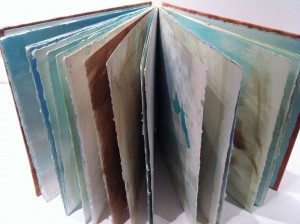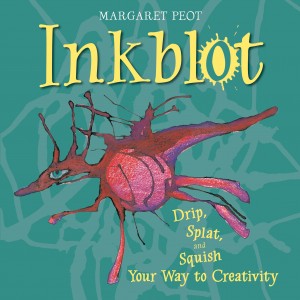
Aging the pages of a sketchbook, or ageing and distressing your art paper is a great way to sidestep creative obstructions…see tip 8, below.
Eight tips for getting past creative blocks: Four last week (http://bit.ly/1hVkO27) , and four this week.
A friend of mine called me in a panic last week–she couldn’t get into her studio. Not because it was blocked with debris from a natural disaster, but because it was blocked with debris from her own mind. She had done everything else she could think of to do to avoid working on the project at hand–a series of illustrations on spec for a writer friend. She cleaned the grout in the bathroom with a toothbrush, she disinfected all the door knobs in the house (it was the tail end of flu season after all), had sorted the books on her shelf according to size, and then resorted them according to color. Does this sound familiar? What was she afraid of? She was going into her studio to do the thing she loved, and yet, she couldn’t get there.
This is an example of major procrastination, sure, but she was also feeling stymied by the project, blocked. Last week I shared four steps to get past creative blocks:
1. Make inkblots
2. Move from your usual working spot or posture to another
3. Work on a schedule
4. Give a tea party for your critics
This week, I suggest:
5. Timer: If you don’t give yourself any time to dither and fret over what you are going to do next, sometimes that is enough to get past a block.
You will need:
Timer (the timer in your phone, for example)
A pad of notebook paper, lined or unlined computer printer paper
Pen or pencil
Scissors
Clear tape
How to:
-Set the timer for thirty seconds–Start!
-Write or scribble on a piece of paper–fill the whole paper, or as much as you can of it. Write anything–what a stupid exercise this is, how much you loathe grocery shopping, whatever. Draw anything–apples, circles, bunnies, anything. At the end of thirty seconds, stop and put your pencil down. Repeat, about eight times. Up the time to 60 seconds, and do that eight times.
-Look at the stack of things you have written or drawn. What do you have?
-With the scissors, cut something you like–a mark, a word–out of every page you have made. Tape those things to a new, clean piece of paper. What do you have? Probably at least ten things that you like, right?
6. Drawing from a Hat: Randomness is a great aid to overcoming creative blocks.
You will need:
Two hats (paper bags also work)
3×5 index cards
Pen or pencil
A book with pictures in it
Paper
How to:
-Flip through the book, writing down things you see in the pictures in the book onto the index card–one thing per card–use things like Horse, Apple, Heart, Chicken. Put about 15 of these index cards into the bag.
-Now write nouns that describe states of mind or more amorphous things–like Inexperience, Age, Angst, Altered States, Happiness, Youth. One per card. Put about 15 of these in the other bag.
-Draw one card from one bag and one card from the other bag. Place the pair on the table. Repeat this until all the cards are paired.
-Pick one pair that strikes your fancy (Inexperience and Chicken, say) and write one sentence about it on the paper. Can you write two sentences? Can you write a sentence about why it strikes you? Can you draw it?
7. Long Spoon: Do you know that quote, “If you sup with the devil, you must use a long spoon”? What if you used a long brush or pen? Sometimes using different muscle groups to make marks can loosen up your brain and get you thinking and making again. This is a technique that theatrical scenic artists use to lay in and paint backdrops that are often painted on the floor.
You will need:
Bamboo cane, dried–like what you can find at a florist–they use them for supports in larger arrangements
Soft lead pencil
Rubber bands
A small roll of brown kraft paper
Masking tape
How to:
-Stick the pencil (you can also use a brush and a bowl of watered ink or watercolor) into the end of the bamboo cane. Secure it with rubber bands, or tape.
-Tape a length of the kraft paper on the floor.
-Stand and draw on the paper taped to the floor.
To take this further, you can take a picture of the marks you have made and print them out smaller, and draw into them–the combination of large gesture on a tiny scale can be energizing.
8. Aging the Page: If it is a blank white page that makes you pack up your supplies and go clean the cat toys, then try aging the page. Having a sumptuously aged surface to draw into and paint over is a wonderful invitation to your mind to dive right in.
You will need:
Three sheets of Rives BFK paper
Ink, black and brown, and water
Large Brush
Paper towels
Natural sponges (optional)
How to:
-Paint all over the paper with water
-Drip the black and brown ink into the water–blobs will form and bleed out in the water. Either leave this and let it dry, or using the paper towel or natural sponge, rub the ink and water together, rubbing into the paper like you were moisturizing a saddle or polishing a table. While this is wet, you can drip water on it (from a height) and it will make interesting marks.

Bonus Tip–Last week I talked about inkblots– This is really my go-to technique…
For more information about making inkblots, drawing into them, and making things from inkblots, check out my book: Inkblot, Drip, Splat and Squish Your Way to Creativity (Boyds Mills) at Amazon http://amzn.to/1fZo9Cm, you can buy the book, and also “look inside.”
